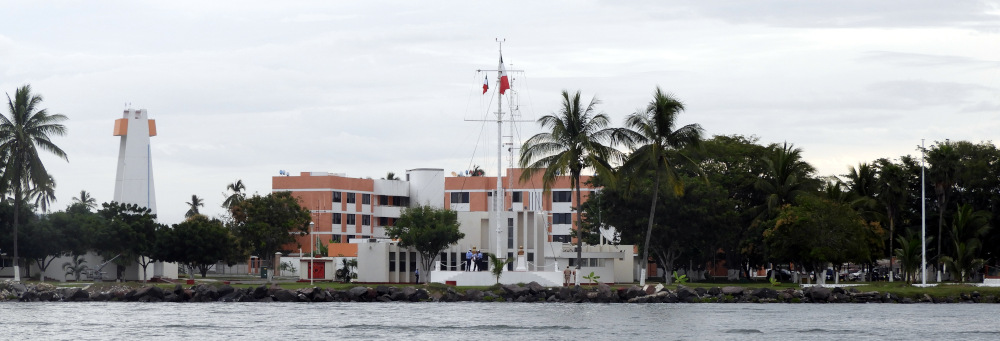
Click on photos to see larger versions... Click here to return to the journal list
San Blas - January 2020
The Journey
|
The morning of Jan 17th found us sailing slowly from lovely Isla Isabel. Along the way we saw distant whales and had a brief visit by dolphins, but it was fishing lines that really encouraged us to keep a sharp lookout. We first spotted a bobbing black flag. Cautiously approaching, we could see there was a line joining it to a bottle maybe 30m away, and another bottle past that, and another, and another...
|

|
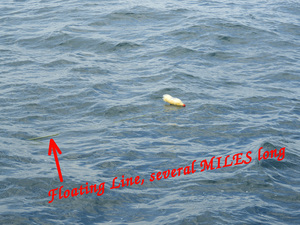
Hard to spot these little bottles and the attached line. The calm weather helped and the continual search for the next one began to feel like a treasure hunt.
|
|
We didn't want to go over the line, fearing it would get trapped between our keel and rudder, messing up both our day and that of the fishers. To go around required a course change, but which way lay the closest end? We made a guess and after two and half miles finally spotted the last marker. It could have been that the other way was shorter but had no way to know; there was no pattern we could discern to denote the end points of these long fishing lines.
|
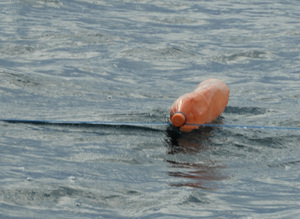
The markers were occasionally flags but more often just small plastic bottles with colourful cloth stuffed inside.
|
For our second encounter, some fishers tending to their line took pity on us, made a temporary break in the barrier, and waved us through. Our third, and last, line we encountered only needed about a mile detour, but we managed to snag the thin anchor rope that projected out to windward from the final float. Happily the rope slid free of our rudder but I was fondly recalling the small boats I had learned to sail on - their rudders could pop up.
|
|
Our trip was also notable because we were able to fly TieDye for over three hours, unlike other times when conditions change shortly after we've gone to all the work to hoist the darned thing. Even more amazingly, the wind died just when it was time to bring the 'chute down, so we had a pleasing paucity of excitement.
|
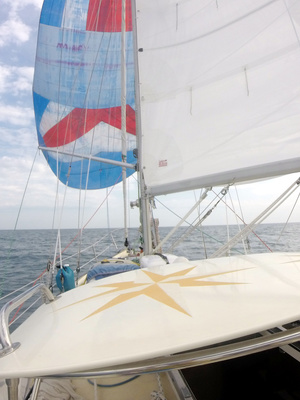
Our spinnaker, named TieDye
|
|

When we said tiny, we weren't kidding. Here's a squished jejene beside a mosquito, also squished. (And that's just a small mozzie, not a northern Ontario mosquito!)
|
We were a bit late arriving at Matanchén but anchored safely in the dark, no thanks to those who forego anchor lights - sheesh! While busy navigating in this new location, stowing sails, and dealing with the anchor, we became sitting ducks for the jejenes (or no-see-ums), tiny bugs that feast on human flesh. We dove under cover as soon as the anchor was down.
San Blas and Matanchén are well known for the little biters, but at least they limit their activities to dusk and dawn. A couple of hours after sunset it was safe to emerge from our stuffy cabin to cool off in the comfortable night air. Some ex-pats in the area are appreciative of how the jejenes keep the area from being overrun by tourists.
|
|
Entering San Blas

Views of town while motoring up channel to San Blas
|
Matanchén is a large bay that is easier to approach than the San Blas harbour entrance three miles to the north; hence, it was a good place to arrive after a long day of sailing but it wasn't our ultimate destination. The next morning when conditions were calm we safely crossed the bar (swatting a few bugs on the way) and travelled up the estuary to San Blas. The town, as seen from the water, struck us as charming. Palm trees line the waterway, lending a truly tropical look and feel.
|
|

Sailboat (not ours!) temporarily grounded on sand bar
|
Near the marina lurks a large shallow patch, the edges of which are denoted by bright red markers. This created some confusion since red should be kept to starboard when going up a channel ("red right returning") yet the chart suggested we should stay to port. After some consternation we trusted the chart, but these anomalies do make one nervous. Despite feedback from other sailors, the powers-that-be are happy with their red markers.
|

Greeting committee as we headed into the marina
|
The Town of San Blas
|
San Blas is located in the state of Nayarit; our guide book describes it as "...a small harbor town with old world charm" (Pacific Mexico: A Cruiser's Guidebook, Breeding & Bansmer). It was officially founded as a colonial town in 1768 and served as the Pacific naval port for New Spain. The Spanish built a fort which changed hands in the 1810 Spanish-Mexican war for independence. After the war, the port of San Blas gradually became less important; the town is now one-third the size it was in its heyday but some structures remain from that time, including cobblestone streets.
|

The long arm of the Barb pointing out San Blas.
|
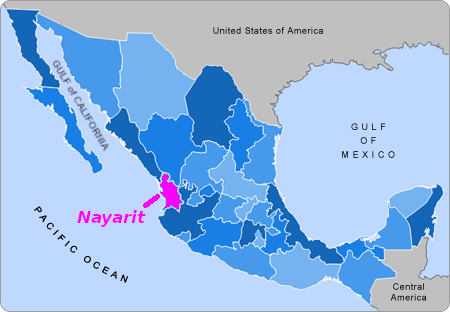
|
|
Along with several other sightseers we visited the fort and the Templo de la Virgen del Rosarío church. Pacific Mexico: "This church was built in 1769 and remained active until 1872, when the aging bells from the belfry were removed. The silencing of these bells proved to be inspirational to the poet, Henry Wadsworth Longfellow, who went on to write the famous poem, The Bells of San Blas."
|

We like monuments dedicated to seafarers.
|
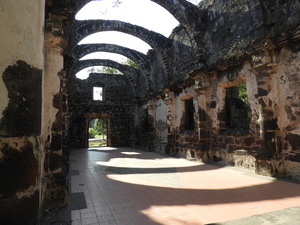
Inside the Temple - fortunately not a rainy day.
|
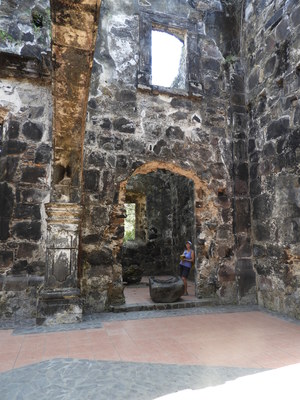
A side-room in the temple with a basin at the entrance.
|

Banyan Tree near Temple
|

The Fort, with the modern-day equivalent of signal flags on top.
|

From the fort one could watch for enemies approaching by sea, and keep an eye on the town.
|

We discovered most of the cannons were now concrete replicas - good for frightening short-sighted enemies!
|

|

A large cemetary just down the road from the fort impressed us with the artwork on the gate and wall
|

although the picture to the right brought to mind the rock band KISS.
|
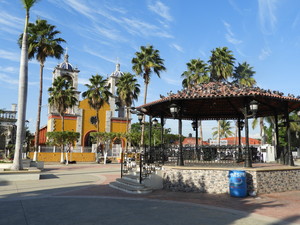
Pigeon-topped pagoda and cathedral in Town Square
|
Bordering the town square is a cathedral and many one or two-story shops and restaurants. Benches are perfect for relaxing on while eating ice cream, enjoying the gardens, and observing pigeons. Nearby, a market features vendors selling beautiful handiwork. The Huichol people are the indigenous folks of Nayarit and there are many examples of their intricate bead work. We patronized a couple of eating establishments and Bjarne purchased a tool we've lacked for a long time: a machete. In the south pacific, five-year-olds walk around with them - we need one too!
|

Statue of dancers in the town square - maybe not the feather in the cap the artist was imagining.
|
|
In addition to pigeons, San Blas is home to over 300 bird species, some of which feast on jejenes - bring on the birds! Our visit coincided with the International Festival of Migratory Birds. Early mornings, our dock flocked with avid avian admirers, binoculars and coffee in hand, waiting to embark on bird-watching adventures. The town square was set up with displays of avian-themed art and a stage for evening entertainment. We missed the bands but did catch one show: children of ages from about 11 to 16 performing traditional Mexican dances. Most amusing was a wedding song that began with the young groom struggling to escape while his buddies dragged him toward the waiting bride. Most of the dances were very lively and we imagined the boys in fringed black leather jackets were quite warm by the end.
|

Great Kiskadee
|

We deemed him a handsome fellow and suspect he thought so too.
|
|
The Fonatur marina had a nice view of the estuary and was inexpensive, but had only cold showers and intermittent Wifi. Worse, it lacked laundry facilities and we had built up a good pile of less-than-fresh items. We hauled our sack of soiled attire off to a lavenderia about a 15 minute walk away. Upon returning a few hours later, the proprietor explained that our laundry was not yet done because - and this took us a while to puzzle out - some of our clothes needed additional cleaning. We appreciated her diligence but felt some guilt that we'd given such grubby garments to someone with higher standards than ours. In the process, we learned a new spanish word: mancha, meaning spot or stain. Later that night we met a white dog with tan patches - guess what its name was :-)
|

Sunset at the Fonatur Marina
|
|
The Estuaries and Wildlife
|
Some of the wildlife here is not what we are used to. Crocodiles live in the estuaries and the rivers that flow into them. No swimming in those spots! Folks on the boat beside us said they'd found a boa constrictor in their cockpit - yikes! Somehow it is more disconcerting that they were on the boat for about an hour before they lifted a towel to discover the visitor. They believe the sounds from their African Grey parrot lured the snake aboard, although it couldn't get at the bird. Apparently, boa constrictors usually prefer prey smaller than humans but it's okay that we didn't have to test that theory.
|

Heading through mangrove tunnel
|

Pretty Butterfly, well-camouflaged
|
We took our dinghy past San Blas, farther up Estero el Pozo on a poorly-timed expedition: the strength of the current greatly hampered our progress. Nonetheless, we enjoyed the scenery along the waterway lined with palm trees and mangroves, all with a mountainous backdrop. A butterfly, disguised like a leaf, hitched a short ride with us. We couldn't resist exploring some much smaller side channels, or more accurately tunnels, leading into the mangroves. There is a lot of popping and crackling amongst the mangroves and one is quite hidden from the rest of the world in these channels. We had little luck capturing the many birds on "film". The only other animal we saw was a racoon climbing amongst the mangrove branches, but later we remembered boa constrictors might also consider this their territory.
There is a company near San Blas that runs a jungle tour up the Rio Tovara; here one may encounter more wildlife. You'll have to read our next blog post to find out what we saw there (hint - some had lots of teeth).
Departure Time
Near the end of our stay, the marina livened up with a few cruisers returning from land touring. We joined them for dinner and animated conversation on our last night. So, we had clean laundry, were provisioned, had done some boat chores, wandered around many parts of town, supported the local economy, and had seen crocodiles. Our work here was done. (Actually, we'd neglected to get pesos from the bank but perhaps having a spending limit at the next place is not such a bad thing.) The morning of January 25th found us heading south for Ensenada Chacala. As we left the estuary, the naval base was just raising the colours (flags), probably in honour of us, right?
